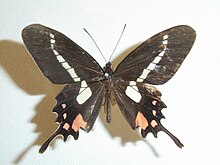| Parides agavus | |
|---|---|

| |
| Scientific classification | |
| Domain: | Eukaryota |
| Kingdom: | Animalia |
| Phylum: | Arthropoda |
| Class: | Insecta |
| Order: | Lepidoptera |
| Family: | Papilionidae |
| Genus: | Parides |
| Species: | P. agavus |
| Binomial name | |
| Parides agavus (Drury, 1782) | |
| Synonyms | |
| |
Parides agavus, the Agavus Cattleheart, is a species of butterfly in the family Papilionidae. It is found in Brazil, Paraguay, and north Argentina.
The red anal spot of the hindwing very large and z-shaped. The abbreviated white band of the hindwing is somewhat variable. A full description is provided by Rothschild, W. and Jordan, K. (1906)
It is not uncommon, even in gardens. Adults frequent flowers. It is not thought to be threatened. Parides agavus is ranched in Brazil.
The larvae feed on Aristolochia triangularis and Aristolochia fimbriata.
Description from Seitz
For a key to the terms used, see Glossary of entomology terms.P. agavus Drury (lb). The red anal spot of the hindwing very large, Z-shaped. The abbreviated white band of the hindwing is somewhat variable. Although the species is quite common even in gardens in the neighbourhood of Rio, especially in damp, shady places, we are still ignorant of its early stages. The insect frequents flowers, and is easy to catch. — Minas Geraes southwards to Rio Grande do Sul, westwards to Paraguay and the adjoining parts of Argentina; not extending to the foot of the Andes.
Taxonomy
Parides agavus is a member of the ascanius species group ("Fringe-spots white. Hindwing with submarginal spots and usnally also discal spots or dots, or a discal band; mostly with tail"). A quadrate whitish spot in space 2 of the forewings is quite peculiar of the ascanius group
The members are
- Parides agavus (Drury, 1782)
- Parides alopius (Godman & Salvin, )
- Parides ascanius (Cramer, )
- Parides bunichus (Hübner, )
- Parides gundlachianus (C. & R. Felder, 1864)
- Parides montezuma (Westwood, 1842)
- Parides phalaecus (Hewitson, 1869)
- Parides photinus (Doubleday, 1844)
- Parides proneus (Hübner, )
Etymology
It is named in the classical tradition. In Greek mythology Agave was a Nereid.
References
- Drury, D. 1770–1782. Illustrations of Natural History London, White.
- Rothschild, W. and Jordan, K. (1906). A revision of the American Papilios. Novitates Zoologicae 13: 411-752. (Facsimile edition ed. P.H. Arnaud, 1967) and online
 This article incorporates text from this source, which is in the public domain.
This article incorporates text from this source, which is in the public domain.
- Collins, N. Mark; Morris, Michael G. (1985). Threatened Swallowtail Butterflies of the World: The IUCN Red Data Book. Gland & Cambridge: IUCN. ISBN 978-2-88032-603-6 – via Biodiversity Heritage Library.
-
Jordan, K., in Seitz, A. ( 1907) . The Macrolepidoptera of the World. 5: The Macrolepidoptera of the American faunistic region. Papilionidae 1-45.
 This article incorporates text from this source, which is in the public domain.
This article incorporates text from this source, which is in the public domain.
- Möhn, Edwin (2006). Schmetterlinge der Erde, Butterflies of the World Part XXVI (26), Papilionidae XIII. Parides. Edited by Erich Bauer and Thomas Frankenbach Keltern: Goecke & Evers; Canterbury: Hillside Books. ISBN 978-3-937783-27-7 (Supplement 13 in English - by Racheli)
- Racheli, Tommaso an Olmisani. Luca 1998. A cladistic analysis of the genus Parides Hubner, , based on androconial structures (Lepidoptera: Papilionidae). Neue Ent. Nachr. (Marktleuthen),41:119-131.pdf
- Lewis, H.L. (1974). Butterflies of the World ISBN 0-245-52097-X Page 25, figure 19
External links
- Butterfly corner Images from Naturhistorisches Museum Wien
| Taxon identifiers | |
|---|---|
| Parides agavus | |
| Papilio agavus | |